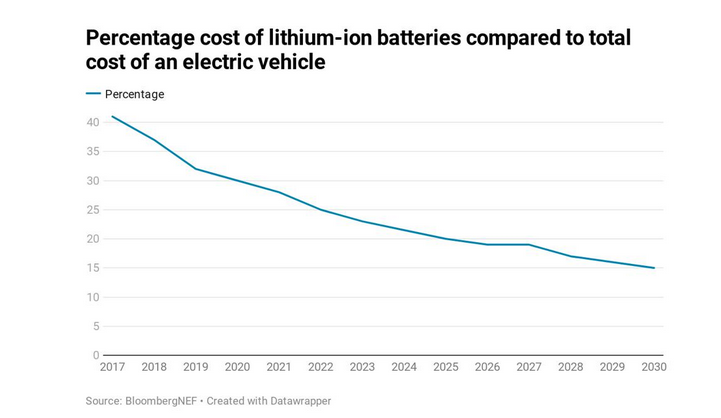Xiaomi US7: The Affordable and Powerful Electric Car
Xiaomi, the Chinese electronics giant, has made a grand entrance into the electric vehicle (EV) market with the highly anticipated US7. This sleek sedan promises to shake things up with its cutting-edge technology, impressive performance, and potentially disruptive pricing.
Head-Turning Design
The US7 boasts a modern and sophisticated design that's sure to turn heads. Its aerodynamic silhouette features a sharp front end, flowing lines, and a spacious cabin. The car comes in a variety of colors, including a stunning pearl white and a sporty midnight black.
Thrilling Performance
Xiaomi hasn't skimped on power. The US7 is equipped with a powerful electric motor that delivers exhilarating acceleration and a top speed of over 120 miles per hour. The car also boasts a long driving range of up to 500 miles on a single charge, making it perfect for road trips and daily commutes alike.
Technology Takes the Wheel
The US7 is packed with cutting-edge technology that makes driving a breeze. The car's in-car system, powered by Xiaomi's own HyperOS, features a large touchscreen display and voice control for managing everything from navigation and music to climate control and charging. The US7 also comes equipped with a suite of advanced driver-assistance systems (ADAS) that help keep you safe on the road.
Disruptive Pricing
While the official price of the US7 has not yet been announced, Xiaomi has hinted that it will be significantly lower than comparable EVs from established automakers. This aggressive pricing strategy could make the US7 a major game-changer in the EV market.
The Future of EVs is Here
The Xiaomi US7 represents a significant step forward in the development of electric vehicles. With its combination of stunning design, powerful performance, cutting-edge technology, and potentially disruptive pricing, the US7 is poised to make a big impact on the market. If you're looking for an exciting and innovative EV, the US7 is definitely worth keeping an eye on.
Here are some additional details about the Xiaomi US7:
- Battery range: Up to 500 miles
- Acceleration: 0-60 mph in under 4 seconds
- Top speed: Over 120 mph
- Available features: Panoramic sunroof, heated and cooled seats, driver-assistance systems, and more
It's important to note that the Xiaomi US7 is still in the early stages of production and is not yet available for purchase. However, deliveries are expected to begin in China in early 2024, with a global launch planned for later in the year.
Introducing the Luvly O
Move over, meatballs and flat-pack furniture, there's a new Swedish export taking the world by storm – the Luvly O. This adorable electric microcar isn't just redefining urban mobility, it's doing it with an innovative twist that owes a debt of gratitude to everyone's favorite Swedish home goods store, IKEA.
Flat-Pack Fun: Imagine a car that arrives on your doorstep, not in a shiny showroom trailer, but in a neat little box. That's the magic of the Luvly O. Its ingenious flat-pack design allows for efficient shipping and reduced carbon footprint, making it a breath of fresh air in the often-polluting world of automobiles. Think of it as the ultimate adult Lego set, only instead of tiny plastic bricks, you get a fully functional electric vehicle!
Small But Mighty: Don't let its size fool you, the Luvly O packs a punch. This city slicker zips through traffic with its peppy electric motor, boasting a range of around 62 miles on a single charge. Perfect for your daily commute, grocery runs, or weekend errands, the Luvly O is designed to conquer the urban jungle with ease. Plus, its compact dimensions make finding parking a breeze – no more circling the block for hours on end!
Sustainable Smarts: The Luvly O isn't just cute and convenient, it's also incredibly eco-friendly. Its electric powertrain means zero tailpipe emissions, contributing to a cleaner, greener future. And with its swappable batteries, you can say goodbye to long charging times. Simply pop in a fresh battery and you're good to go – it's like a pit stop for the 21st century!
More Than Just a Car: The Luvly O is a symbol of a changing world. It's a testament to Swedish ingenuity and a commitment to sustainable living. It's a car that doesn't take itself too seriously, but takes its responsibility to the planet very seriously indeed.
So, whether you're an eco-conscious commuter, a space-savvy city dweller, or simply someone who appreciates a good dose of Swedish charm, the Luvly O is definitely worth keeping an eye on. This little flat-pack wonder is poised to revolutionize the way we think about urban mobility, one adorable electric bubble car at a time.
Ready to join the Luvly O revolution? Pre-orders are now open, with deliveries expected to begin in late 2024. So, grab your Allen key, dust off your inner IKEA maestro, and get ready to welcome the future of urban mobility – it arrives in a box!
My Experience Visiting the NIO Showroom in Guangzhou
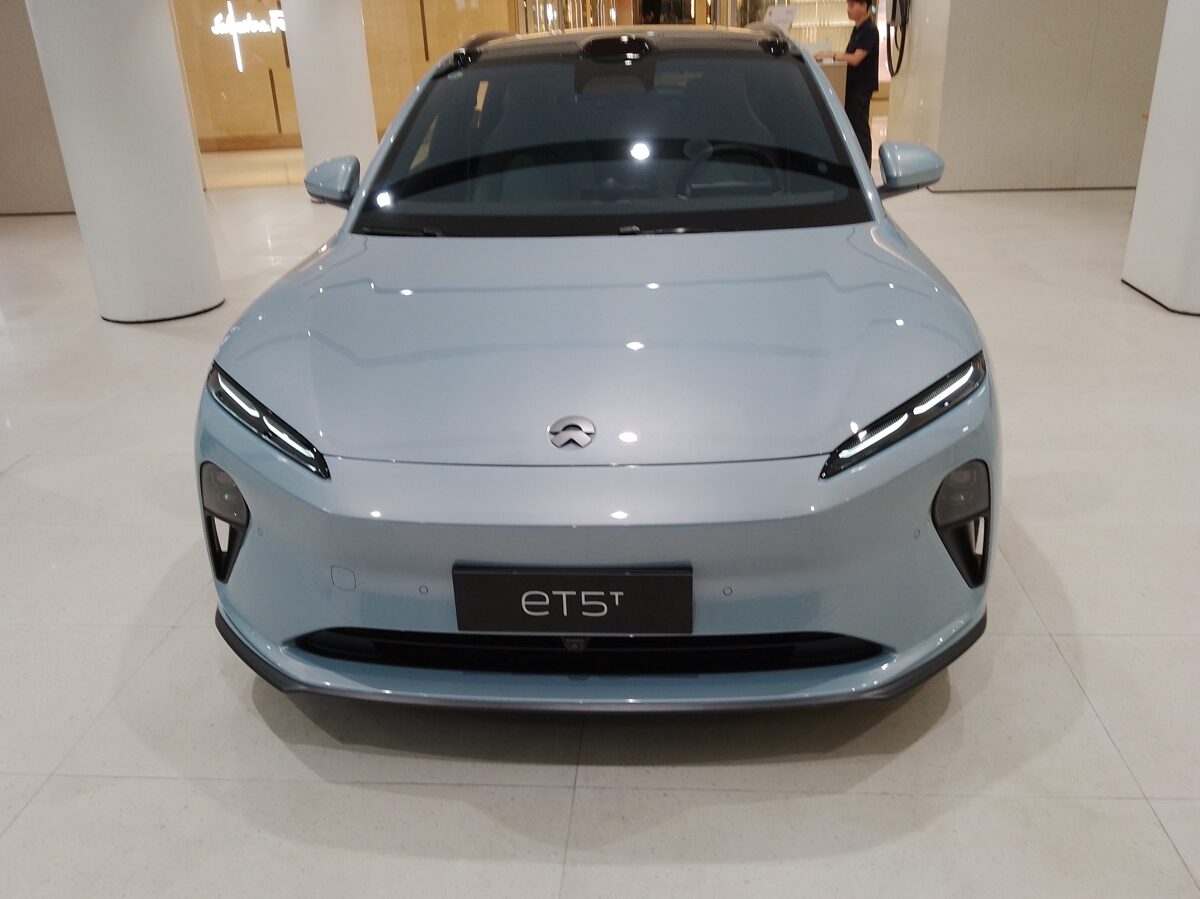
I recently had the opportunity to visit the NIO showroom in Guangzhou, China. I was very pleased with the showroom itself, which is spacious, modern, and welcoming. The staff were also extremely friendly and knowledgeable. They were able to answer all of my questions about NIO cars and the company's battery swap station technology in detail.
I also had the chance to examine the NIO ET5, the company's latest electric car. I was very struck by the car's design and features. It is a very stylish and luxurious car.
Finally, I also had the opportunity to take a look at NIO's Battery swap station technology. This is a very innovative technology that allows NIO car owners to quickly and easily swap out their depleted batteries for fresh ones. I was very fascinated with this technology and I believe it has the potential to transform the electric car industry.
Overall, I had a very positive experience visiting the NIO showroom in Guangzhou. I would highly recommend it to anyone who is interested in learning more about NIO cars and the company's battery swap station technology.
Here are some of the things I liked about the NIO showroom:
- It is spacious, modern, and welcoming.
- The staff are friendly, knowledgeable, and helpful.Thanks a lot Mr. Haikun
- They have a wide variety of NIO cars on display.
- They have a battery swap station on site so you can see how it works.
- I would highly recommend visiting the NIO showroom in Guangzhou if you are ever in the area. I believe you will be impressed with what you see.

The Future of EV Charging in the Gulf Countries
EVKSA

The future of electric vehicle (EV) charging in the Gulf Cooperation Council (GCC) is bright, with governments and businesses investing heavily in infrastructure and technology. The region is well-positioned to become a global leader in EV adoption, thanks to its abundant renewable energy resources and strategic location.
Here are some of the key trends that are shaping the future of EV charging in the GCC:
- Government support: GCC governments are committed to promoting the adoption of EVs and have introduced a number of supportive policies, such as subsidies, tax breaks, and preferential parking. For example, Saudi Arabia has set a target of having 30% of its vehicles electric by 2030, and the UAE is aiming to have 42,000 EVs on its roads by 2030.
- Private sector investment: Private companies are also investing heavily in EV charging infrastructure in the GCC. For example, Dubai Electricity and Water Authority (DEWA) has announced plans to install 10,000 EV charging stations across the emirate by 2030.
- New technologies: New technologies are emerging that are making EV charging faster, more convenient, and more affordable. For example, ultra-fast chargers can now top up an EV battery in just a few minutes.
- Smart charging: Smart charging solutions are being developed that can help to optimize the use of EV charging infrastructure and reduce costs. For example, smart chargers can be used to charge EVs during off-peak hours when electricity is cheaper.
These trends are expected to drive significant growth in the EV charging market in the GCC in the coming years. A recent report by Mordor Intelligence predicts that the GCC EV charging market will grow at a CAGR of 27.3% from 2022 to 2028.
Here are some of the specific ways in which EV charging in the GCC is expected to evolve in the future:
- More charging stations: The number of EV charging stations in the GCC is expected to increase significantly in the coming years. This will be driven by both government and private sector investment.
- Faster charging: New ultra-fast charging technologies will make it possible to charge EVs in just a few minutes. This will help to address one of the main concerns of potential EV buyers, which is the time it takes to charge an EV.
- More convenient charging: EV charging will become more convenient in the future with the development of smart charging solutions. For example, smart chargers will be able to charge EVs during off-peak hours and automatically adjust the charging rate based on the battery level.
- More affordable charging: The cost of EV charging is expected to come down in the future as battery technology improves and the cost of renewable energy decreases. This will make EVs more affordable to operate and maintain.
The future of EV charging in the GCC is very promising. With the support of governments and businesses, the region is poised to become a global leader in EV adoption.
In addition to the above, here are some other specific initiatives that are being undertaken in the GCC to promote EV charging:
- Saudi Arabia: Saudi Arabia is investing heavily in EV charging infrastructure as part of its Vision 2030 plan. The kingdom has partnered with a number of companies to develop and deploy EV charging stations across the country.
- UAE: The UAE is also investing heavily in EV charging infrastructure. The country has set a target of having 10,000 EV charging stations by 2030. The UAE is also home to the world's largest solar-powered EV charging station.
- Qatar: Qatar is also investing in EV charging infrastructure as part of its National Vision 2030 plan. The country has partnered with a number of companies to develop and deploy EV charging stations across the country.
- Kuwait: The Kuwait Public Authority for Housing and Urban Development (PAHW) is installing EV charging stations in all new public housing projects.
- The Kuwait Oil Company (KOC) is installing EV charging stations at its petrol stations.
- The Kuwait Ports Authority (KPA) is developing an "EV City" that will include a number of EV charging stations.
- A number of private companies, such as KEC and Zain, are installing EV charging stations at their offices and other locations.
These initiatives are expected to make EV charging more accessible and affordable in the GCC, and to help to accelerate the adoption of EVs in the region.
The GCC Electric Vehicle Market size is estimated at USD 3.66 billion in 2023, and is expected to reach USD 8.75 billion by 2028,
growing at a CAGR of 19.03% during the forecast period (2023-2028). The
automotive industry in the GCC region is majorly dependent on
conventional internal combustion engines
The Global Electric Vehicle Market
The global electric vehicle (EV) market continued to grow in 2022, with sales exceeding 10 million units. This represents a 55% increase from 2021, and is a significant milestone in the transition to a cleaner transportation future.
The growth of the EV market was driven by a number of factors, including government incentives, increasing consumer awareness of the environmental benefits of EVs, and the growing availability of charging infrastructure.
In terms of regional markets, China remained the largest EV market in 2022, accounting for over 40% of global sales. Europe was the second-largest market, with sales growing by 15% year-over-year. The United States also saw strong growth in EV sales, with sales up by 70% in 2022.
Looking ahead, the EV market is expected to continue to grow in the coming years. The International Energy Agency (IEA) projects that EV sales will reach 20 million units in 2023, and 30 million units in 2025.
The growth of the EV market will have a number of positive implications for the environment. EVs produce zero emissions, which will help to reduce air pollution and greenhouse gas emissions. EVs are also more efficient than gasoline-powered vehicles, which means that they can save consumers money on fuel costs.
The growth of the EV market will also create new jobs and opportunities in the automotive industry. As the demand for EVs grows, automakers will need to invest in new production facilities and hire more workers. The EV market is also expected to create new jobs in the areas of charging infrastructure development and battery manufacturing.
The growth of the EV market is a positive development for the environment and the economy. As EVs become more affordable and accessible, they are likely to become the dominant form of transportation in the years to come.
Here are some of the key trends in the global EV market in 2022:
- The increasing availability of charging infrastructure is a major factor driving the growth of the EV market.
- Government incentives are also helping to boost EV sales, particularly in China and Europe.
- The growing popularity of SUVs and pickup trucks is opening up new opportunities for EV manufacturers.
- Battery technology is improving, which is making EVs more affordable and practical.
- The rise of ride-hailing and car-sharing services is also helping to drive the demand for EVs.
The future of the EV market looks bright. As the technology continues to improve and the cost of EVs comes down, they are likely to become the dominant form of transportation in the years to come. This will have a positive impact on the environment and the economy, and will help to create a more sustainable future.
200 Miles for a single charge in 4 minutes
ARK believes that an EV charging rate is a good proxy for overall
performance, capturing the efficiency, range, and power
capabilities of the system. In the past four years, charging rates
have improved nearly three-fold, from 40 to 15 minutes for 200
miles of range. During the next five years, it could drop nearly
four-fold to 4 minutes. As EV charging reaches an acceptable
rate, ARK expects the industry to optimize for other features
like autonomous driving, safety, and entertainment
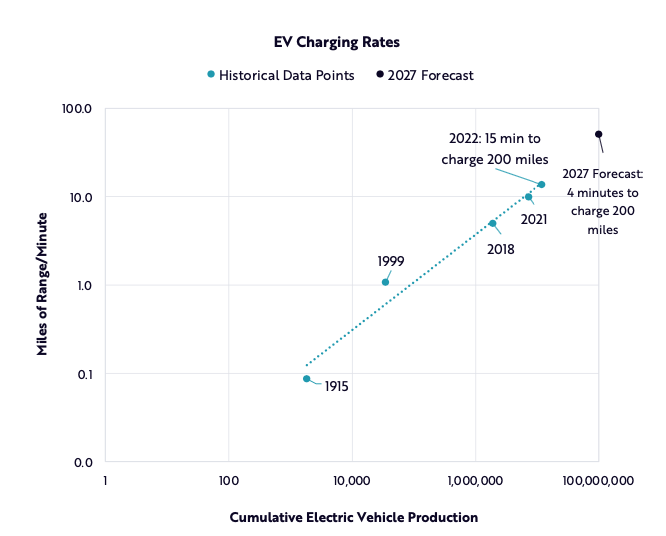
EV charging evolve from a small, niche sector, to one central to some of the biggest industries in the world
There are many signs the transition is underway. Factories are scaling up and purchase commitments are increasing. There's an influx of infrastructure investors and coordination across the charging ecosystem, with automotive, charging, utility and retail sectors working together.
Source :
Bloomberg
The demand for electric vehicles is skyrocketing. Can the supply of lithium and other critical minerals for batteries keep up?
f the world wants to replace all its gas-burning cars and trucks with cleaner electric vehicles, it will have to dig up rocks. A lot of rocks.
Demand for EVs is soaring in many parts of the globe, and a wave of domestic policies will send it skyrocketing in the U.S. soon. The batteries that power all those EVs need minerals — cobalt, nickel, graphite and, in particular, lithium — and the race is now on to mine and process enough of them. Complicating the picture, the minerals needed to fuel the EV boom are also increasingly in demand for energy storage and other clean energy technology. Just as fossil fuels have powered the global economy for the past 150 years, these minerals will be the crux of the energy future.
“We’re in a [lithium] supply deficit as we speak, from the global perspective,” said Andrew Miller, CEO of Benchmark Mineral Intelligence, a consulting firm. “The demand projections are growing a lot quicker than the potential to bring on new supplies.”
Globally, consumers bought 6.6 million plug-in vehicles in 2021, a number projected to triple by 2025. That could lead to 469 million passenger electric vehicles on the road by 2035, according to one projection from BloombergNEF — or 612 million if the world gets on track toward net-zero emissions by midcentury. In the U.S., the Biden administration has set a goal of making half of all new car sales EVs by 2030 — and new legislation like the Inflation Reduction Act and California’s 2035 ban on gas-powered vehicles is putting muscle behind that goal.
The International Energy Agency projects a thirteenfold increase in demand for lithium between 2020 and 2040, based on policies in place in May 2021 — and that’s even if the world isn’t doing so well on climate targets. In a “sustainable development scenario” where the world is on track to meet the climate change goals of the Paris Agreement, lithium will see a 42-fold increase in demand. Other crucial minerals, including graphite, cobalt and nickel, will also see demand jump by a factor of around 20.
Lithium is currently mined in a relatively limited number of countries, with supply dominated by Australia, Chile and only a few others. The U.S., where recent legislation requires that EV batteries increasingly be sourced domestically or from certain trade partners, has very limited lithium mining in operation and permitting rules that may slow efforts to bring more online.
Meanwhile, the world’s second-largest economy is far and away the EV battery and lithium behemoth: Chinese companies dominate the battery supply chain, particularly at the refining and manufacturing stages. That’s a big challenge for the U.S. as it tries to bring the supply chain closer to its shores.
Other minerals are mined in varying locations across the world, often in countries with limited environmental oversight or the potential for significant geopolitical strife. And some seemingly far-out and controversial ideas are coming closer to fruition, such as mining cobalt, nickel and copper from millions of small rocks deep under the Pacific Ocean.
“In order to meet the demands of the Western automotive market, you’re going to need — it can’t all just be coming from one country — you’re going to need a diverse set of suppliers,” Miller said.
Source :
Electric car sales continue to break records
Batteries typically accounts for 30% to 40% of the value of an electric
vehicles (EV), and the race to net zero will focus attention on the
security of supply of the critical minerals and metals needed to
manufacture them.
Electric car sales continued to break records in 2021,
testing the resilience of battery supply chains
Few areas in the world of clean energy are as dynamic as EV
markets. In 2021, EV sales broke new records, with nearly 10% of
global car sales being electric, four times their market share in 2019.
Public and private spending on EVs doubled relative to 2020. More
and more countries have pledged to phase out ICEs or have
ambitious electrification targets. Five times more EV models were
available in 2021 relative to 2015, and most major carmakers are
announcing plans to further accelerate electrification of their fleets.
China accounted for half of the growth of the EV market in 2021. More
vehicles were sold in China in 2021 (3.3 million) than in the entire
world in 2020. Sales in Europe continued to grow robustly (up 65%
to 2.3 million) after the 2020 boom, and they increased in the United
States as well (to 630 000) after two years of decline. The first quarter
of 2022 showed similar sales trends.
Source: Global Supply Chains of EV Batteries Report July 2022
Future of EV Charging in USA
Source: EVGO
U.S. automakers pledge huge increase in electric vehicles
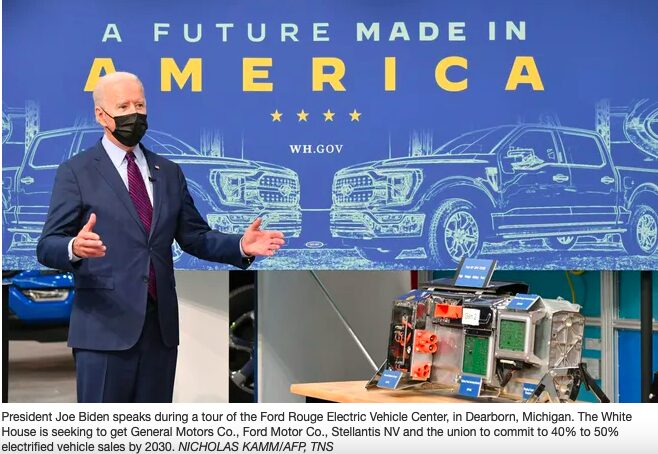
Photo from site : dispatch.com
Declaring the U.S. must “move fast” to win the world’s carmaking future, President Joe Biden today announced a commitment from the auto industry to produce electric vehicles for as much as half of U.S. sales by the end of the decade.
Biden also wants automakers to raise gas mileage and cut tailpipe pollution between now and model year 2026. That would mark a significant step toward meeting his pledge to cut emissions and battle climate change as he pushes a history-making shift in the U.S. from internal combustion engines to battery-powered vehicles.
He urged that the components needed to make that sweeping change — from batteries to semiconductors — be made in the United States, too, aiming for both industry and union support for the environmental effort, with the promise of new jobs and billions in federal electric vehicle investments.
Pointing to electric vehicles parked on the White House South Lawn, the president declared them a “vision of the future that is now beginning to happen.
Source : Star Advertiser"Audi" sets 2026 end date for combustion engine cars
FRANKFURT, June 17 (Reuters) - Volkswagen's Audi unit will stop introducing cars based on petrol and diesel engines from 2026, Sueddeutsche Zeitung reported on Thursday, citing comments made by Audi CEO Markus Duesmann to labour representatives and top managers.
The report said there would also no longer be any hybrid models from that date onwards...
Source:
Every Electric Vehicle That's Expected in the Next Five Years

Electric cars
are the future, and each year we've seen automakers add more EVs to
their lineup. Everyone is working on electric vehicles, from
well-established existing manufacturers to new names such as Byton, Lordstown, and Rivian. We've compiled a list of every electric vehicle, from concept to production, that isn't available yet but will be soon.
Source : CarandDriver.com
Deloitte expects that by 2030 China will hold Half of the global EV market, Europe will account for 27%, and the United States will hold 14%
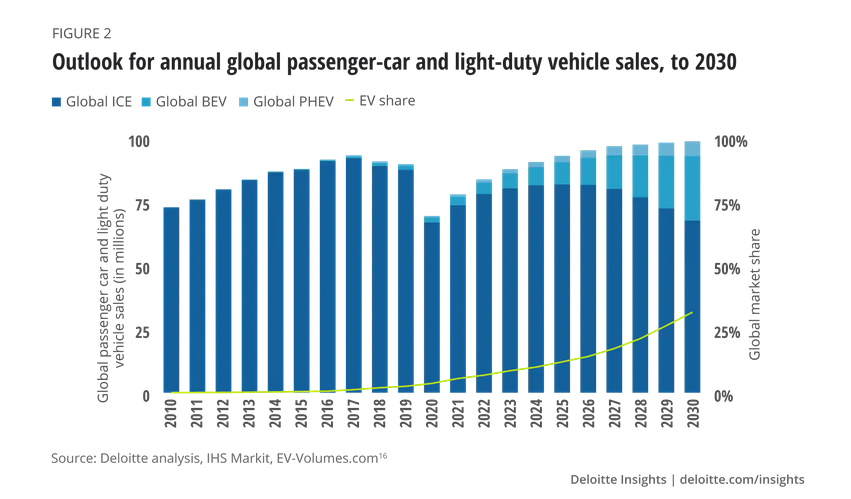
Source : Deloitte
California aims to halt sales of new Gas powered cars by 2035
SACRAMENTO, Calif. (AP) — California will halt sales of new gasoline-powered passenger cars and trucks by 2035, Gov. Gavin Newsom announced Wednesday, a move he says will cut greenhouse gas emissions by 35% in the nation’s most populous state.
The proposed rule would not ban people from owning gas-powered cars or selling them on the used car market. But it would end the sales of all new gasoline-powered passenger cars and trucks in the state of nearly 40 million people.
Source : marketwatch.com
EV Technology Future Milestones
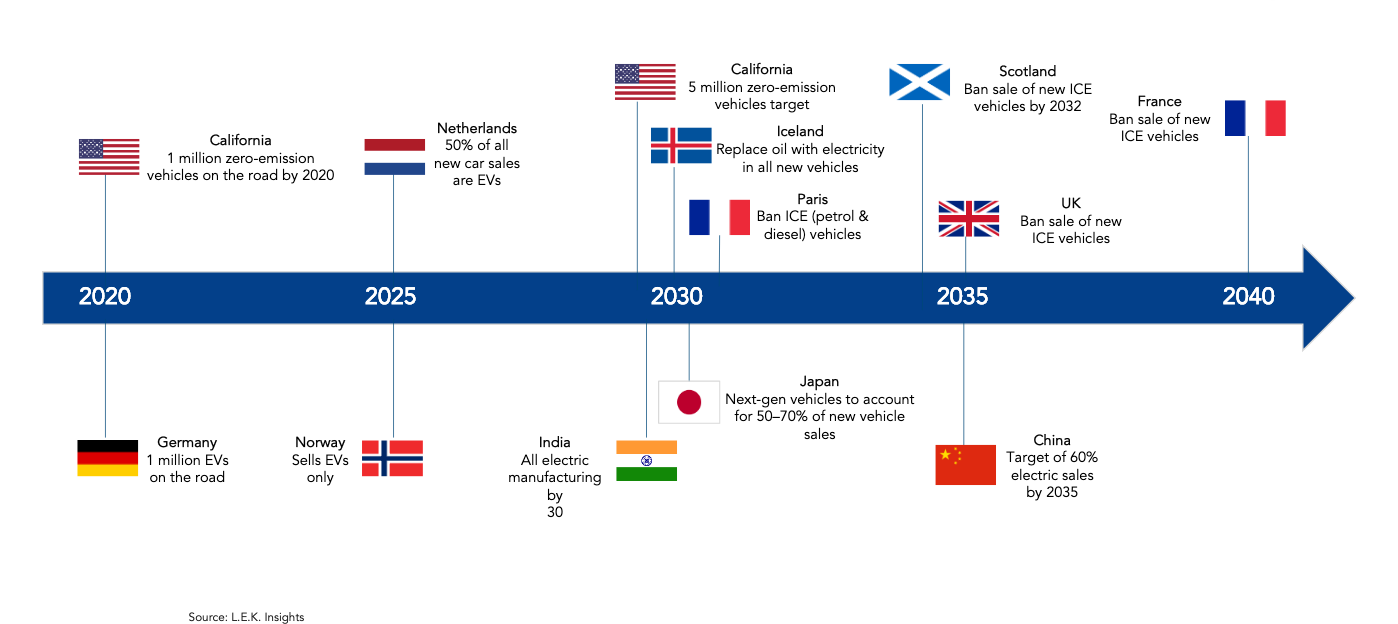
Source : LEK.COM
The cost of batteries for electric vehicles is falling markedly.
EVs Market Policies Scenario
The EVs Groth throw last 2 years

Source :
Agence internationale de l'énergie
..


